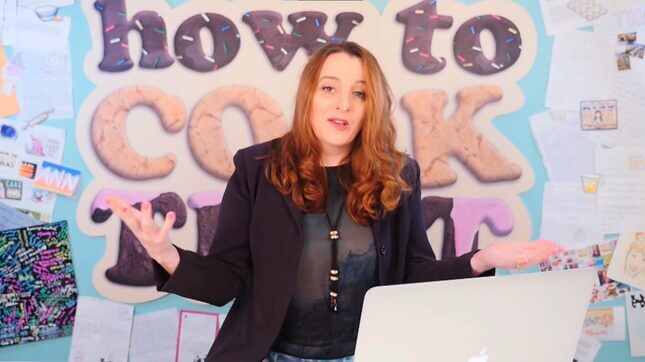

Ann Reardon burns cheese. She burns organic cheese, then “processed cheese.” She pulls up a video from YouTube content mill Blossom, which had recently urged viewers at home to burn their cheeses and spices and other similar food products to determine what was “natural” and therefore “healthy.” She moves on to burning vitamins, then rice, and then a spoonful of turmeric. In her experiments, which are spliced with lessons in food science, Reardon gradually debunks Blossom’s hypothesis. In the process, she exposes a vast network of similarly exploitative Youtube videos under their umbrella designed to pull people in with clickbait headlines, and often promote downright dangerous habits or beliefs.
You can find a hack tutorial online for nearly everything. WikiHow’s many guides, ranging from “how to peel a banana” to “how to disappear completely,” stand as a testament to this fact, as does the very concept of search engine optimization (SEO) and content mills that exclusively publish things like “What Time Is the Super Bowl?” No other place is this more obvious than on Youtube, where video explainers exist for just about every problem known to mankind, and then some that previously weren’t. The newer discoveries in the world of “life hacks” specifically come courtesy of the aforementioned Blossom or channels like 5-Minute Crafts and So Yummy. In “33 GIRLY BEAUTY HACKS || Home and Professional Skincare Routine,” sandwiched between regular dermatologist treatments, 5-Minute Crafts suggests its viewers soak their lips with milk to relieve dry skin. Innocuous, if strange.
Enter “How To Cook That.” In 2018 baker and Australian food scientist Ann Reardon began what could be called a crusade against So Yummy, a channel which confounded her, as a Youtube creator herself. In a video titled “Is So Yummy the WORST baking channel on YouTube?” Reardon laid out the seeming conspiracy behind its constant deluge of recycled content and vast subscriber base, despite its relative newness. So Yummy also boasted more than 100 million views combined, across all of its videos, which was a number staggeringly higher than most other popular creators at the time. Its compilations also featured re-used assets video clips, which is against Youtube’s monetization policies.
As longtime creators like Reardon saw it, the numbers and seeming rule-breaking just didn’t make sense. So, after having debunked So Yummy hacks like “ice cream frosting”—it is chemically impossible to “whip” the milk solids in ice cream with powdered sugar into a stable-at-room-temperature frosting for everyday cakes—Reardon explained her motivations in coming after So Yummy. Through a series of graphs she illustrated how in the last year alone, cooking creators had exited the space en masse due to the growing competition from these alleged content mills.
In the years since, Reardon has ventured into the world of baking hacks, in which she debunks viral recipes and videos uploaded by these content farms. Among my favorites are a fabled “easy caramel” using a microwave; another involving microwaved eggs and marshmallows; “Diet Coke” flavored watermelon; and worse yet, dying clothes green with old and moldy spinach. In her 2019 video “Is 5-Minute Crafts the WORST channel on YouTube?” she discusses the outpouring of support from her ventures into the world of baking hacks, and the stories she’s heard from people about the dangers they exposed themselves to with some of the videos they’ve watched, either through food unsafe for consumption, or dangerous mixing of chemicals suggested in such videos.
Her crusade is noble and throughout her now years-long engagement with channels like 5-Minute Crafts, Reardon has become quite adept at navigating their viral schemes, all the way down to how thumbnails are put together. But the success of said crusade would not be possible in the slightest if Reardon wasn’t delightful to watch. Her humor is lighthearted, even when faced with the money hungry corporations eradicating creators like her—whether intentionally or not. She also doesn’t take herself very seriously, as evidenced by her joy when Australian drag queen duo Novympia parodied her debunking videos.She’s also a fantastic baking instructor, and her channel also includes zany cake ideas like a Minecraft Cake Village and ancient baking recipes from Pompeii found on ancient stone tablets. To say that I’ve been in the mood for lighter fare this last year would be a colossal understatement. But more than other content indulgences I’ve found myself binging, Reardon’s passion for her craft and dedication for making Youtube a better environment for everyone is positively infectious. Her joy bleeds through the screen and I can barely contain my excitement when that notification dings each second week of the month.
Her approach to food science is immediately accessible, and I’ve learned quite a bit about my own misconceptions when it comes to modern food trends. For instance, the duplicitous marketing behind “clean” and “organic” food brands and what sort of food is considered “natural.” It’s almost genius how she’s combined both hack videos and actual science into a weapon with which she combats the manipulations of corporate interests.By her growing popularity, it’s apparent that her love of food chemistry cuts through much of the noise blasted out by the Wellness industry. In one video, she debunks a viral claim that meat is “glued together” and therefore toxic to eat—something that sounds so ridiculous, it’s almost hard to stomach how popular that idea is. Later on, she tackles a similar conspiracy that rice growers seed their crops with plastic to cut costs, even if plastic is more expensive per pound than rice will ever be. Disinformation campaigns aside, as an otherwise grizzled media journalist, it feels almost silly to find this much pleasure in what is, at its core, a simple baking Youtube channel. But that’s the magic of How to Cook That, and content mills everywhere better watch their fucking backs!